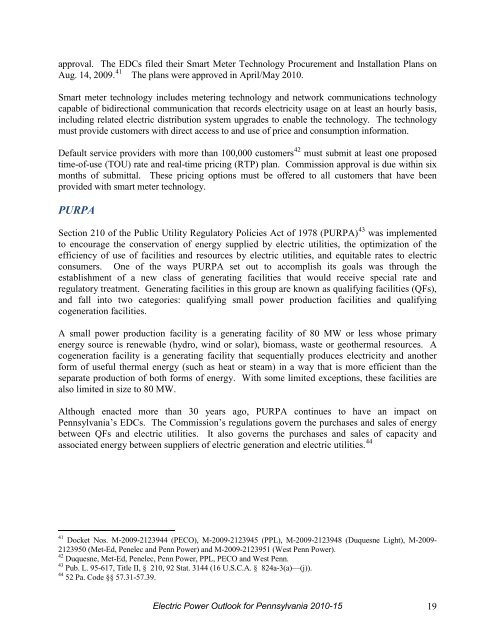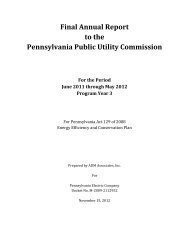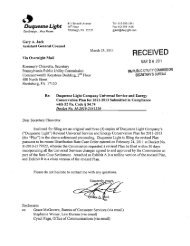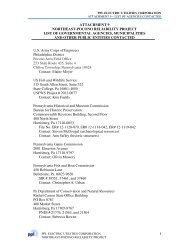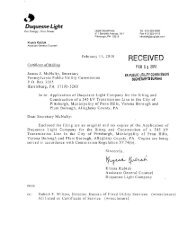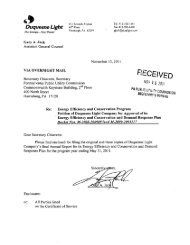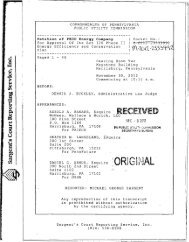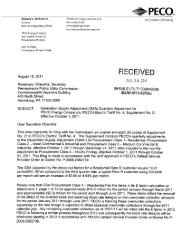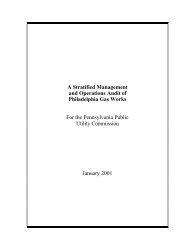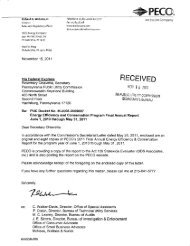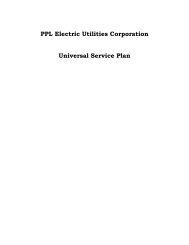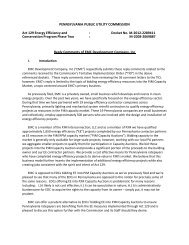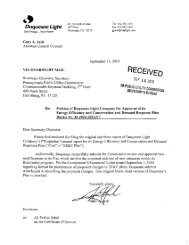Electric Power Outlook - Pennsylvania Public Utility Commission
Electric Power Outlook - Pennsylvania Public Utility Commission
Electric Power Outlook - Pennsylvania Public Utility Commission
Create successful ePaper yourself
Turn your PDF publications into a flip-book with our unique Google optimized e-Paper software.
approval. The EDCs filed their Smart Meter Technology Procurement and Installation Plans on<br />
Aug. 14, 2009. 41 The plans were approved in April/May 2010.<br />
Smart meter technology includes metering technology and network communications technology<br />
capable of bidirectional communication that records electricity usage on at least an hourly basis,<br />
including related electric distribution system upgrades to enable the technology. The technology<br />
must provide customers with direct access to and use of price and consumption information.<br />
Default service providers with more than 100,000 customers must submit at least one proposed<br />
time-of-use (TOU) rate and real-time pricing (RTP) plan. <strong>Commission</strong> approval is due within six<br />
months of submittal. These pricing options must be offered to all customers that have been<br />
provided with smart meter technology.<br />
PURPA<br />
Section 210 of the <strong>Public</strong> <strong>Utility</strong> Regulatory Policies Act of 1978 (PURPA) was implemented<br />
to encourage the conservation of energy supplied by electric utilities, the optimization of the<br />
efficiency of use of facilities and resources by electric utilities, and equitable rates to electric<br />
consumers. One of the ways PURPA set out to accomplish its goals was through the<br />
establishment of a new class of generating facilities that would receive special rate and<br />
regulatory treatment. Generating facilities in this group are known as qualifying facilities (QFs),<br />
and fall into two categories: qualifying small power production facilities and qualifying<br />
cogeneration facilities.<br />
A small power production facility is a generating facility of 80 MW or less whose primary<br />
energy source is renewable (hydro, wind or solar), biomass, waste or geothermal resources. A<br />
cogeneration facility is a generating facility that sequentially produces electricity and another<br />
form of useful thermal energy (such as heat or steam) in a way that is more efficient than the<br />
separate production of both forms of energy. With some limited exceptions, these facilities are<br />
also limited in size to 80 MW.<br />
Although enacted more than 30 years ago, PURPA continues to have an impact on<br />
<strong>Pennsylvania</strong>’s EDCs. The <strong>Commission</strong>’s regulations govern the purchases and sales of energy<br />
between QFs and electric utilities. It also governs the purchases and sales of capacity and<br />
associated energy between suppliers of electric generation and electric utilities. 44<br />
42<br />
43<br />
41 Docket Nos. M-2009-2123944 (PECO), M-2009-2123945 (PPL), M-2009-2123948 (Duquesne Light), M-2009-<br />
2123950 (Met-Ed, Penelec and Penn <strong>Power</strong>) and M-2009-2123951 (West Penn <strong>Power</strong>).<br />
42 Duquesne, Met-Ed, Penelec, Penn <strong>Power</strong>, PPL, PECO and West Penn.<br />
43 Pub. L. 95-617, Title II, § 210, 92 Stat. 3144 (16 U.S.C.A. § 824a-3(a)—(j)).<br />
44 52 Pa. Code §§ 57.31-57.39.<br />
<strong>Electric</strong> <strong>Power</strong> <strong>Outlook</strong> for <strong>Pennsylvania</strong> 2010-15 19


